- Furniture
- 0 likes
- 1047 views
- 0 comments

If there’s one colour that connects us with nature, brings a sense of serenity, and still manages to make a bold design statement, it’s green.
From moody forest tones to soft sage and playful mint, green is one of the most versatile colours in the decorating palette. Whether you're craving a serene sanctuary or want to inject personality into a dull room, green can help you achieve the vibe you’re after.
In this guide, we’ll show you how to bring green into every area of your home, with expert tips on colour pairing, textures, tones, and placement, plus our green furniture inspiration.
Why Choose Green for Your Home?
Green is the perfect harmony between warm and cool tones. It grounds a space without overwhelming it, adds a sense of freshness, and complements natural materials beautifully. Depending on the shade, green can energise a kitchen, soften a bedroom, or bring drama to a living room.
Psychologically, green evokes growth, balance, and tranquillity, making it ideal for creating a calm yet characterful home.
Choose the Right Shade for the Mood You Want
Each tone of green tells a different story. Before you start styling, decide what feeling you want your space to evoke.
- Sage & eucalyptus green - soft, calming, perfect for bedrooms, bathrooms, and minimalist interiors.
- Olive & moss green - earthy, grounding, ideal for rustic kitchens, boho living rooms, and cosy dining areas.
- Emerald, forest & bottle green - rich and dramatic, best for bold feature walls, velvet upholstery, and moody spaces.
- Mint & pistachio - light and fresh, great for contemporary kitchens, children’s rooms, or retro vibes.
You can use paint samples or fabric swatches to see how a green shade looks in different light throughout the day; it can shift more than you'd expect.
.jpeg)
Green as a Neutral
Olive, sage, and muted moss greens are surprisingly neutral. These earthy hues blend effortlessly with wood, rattan, leather, and even soft pastels, giving you endless flexibility. Use them in larger furniture pieces to anchor a room without overwhelming it.
Treat olive green like you would beige or grey; it's a perfect base tone that pairs beautifully with warm woods and textured fabrics.
The HKLiving Olive Green Storage Cupboard is a great example of a large green piece that makes a subtle yet striking statement. Its clean lines and calming tone make it ideal for bedrooms, dining rooms, or even stylish home offices.
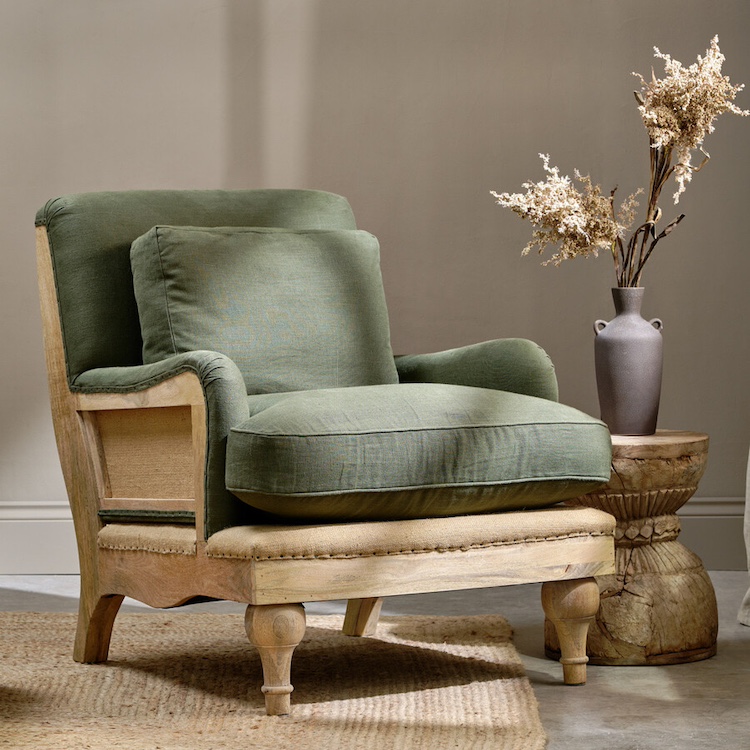
Likewise, the Abe Deconstructed Linen Armchair in Olive, which brings in texture and natural materials like mango wood and hessian. Adding this to your room will create a beautifully grounded corner full of character.
.webp)
Add Drama with Jewel Tones
Want to go bolder? Deep, rich greens like emerald, forest, or vine bring a sense of opulence and mood. These are perfect for velvet fabrics, leather accents, or statement seating. They instantly make a room feel more luxurious, especially when paired with brass or marble.
Don’t be afraid to go full glam. Green velvet with gold accents or rich leather chairs can add real drama without feeling fussy and can work especially well if you’re seeking a vintage style, like Art Deco, mid-century or industrial.
The Swyft Model 02 Three Seater Sofa in Vine Velvet has a timeless, mid-century vibe with its pulled seam detailing and round bolster cushions. The deeper green velvet finish adds a touch of luxury to your space.
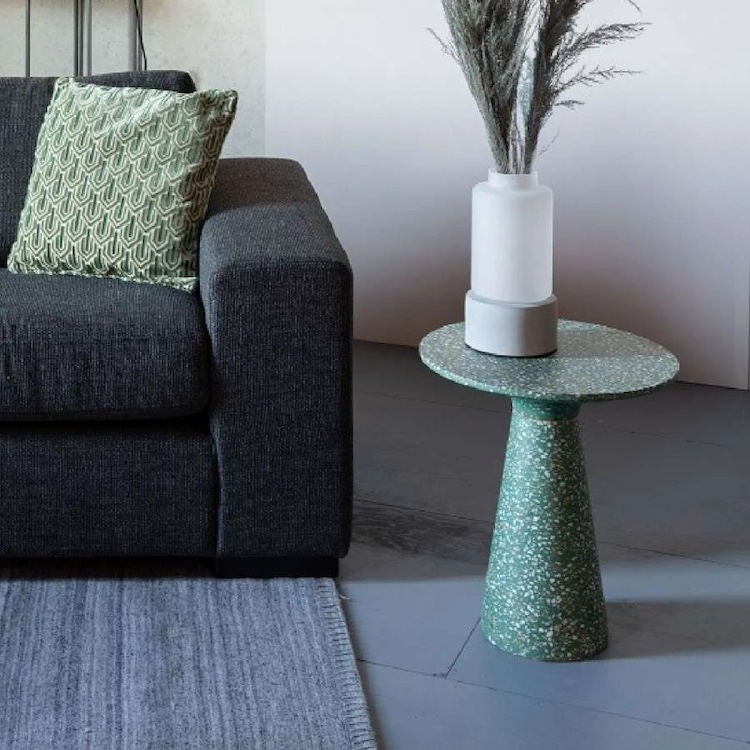
Layer Green Tones for Depth
Green doesn’t have to match perfectly to work well. In fact, using different tones, from pale pistachio to deep pine, creates a layered, curated look. Try layering multiple shades of green, just like in nature, to create depth. Try pairing mossy greens with fresh leafy tones or mixing cool mint with warm olive for interest.
You can do this through textiles, artwork, furniture and accessories. Start with a dominant green (like a sofa or armchair), then add smaller accents in varying shades; vases, cushions, or a piece of art featuring leafy tones.
Add the Victoria Terrazzo Side Table, which works both indoors and outdoors, for a fresh pop of green with artisan appeal. The terrazzo’s flecked pattern introduces a subtle variation in tone and texture that keeps things interesting.
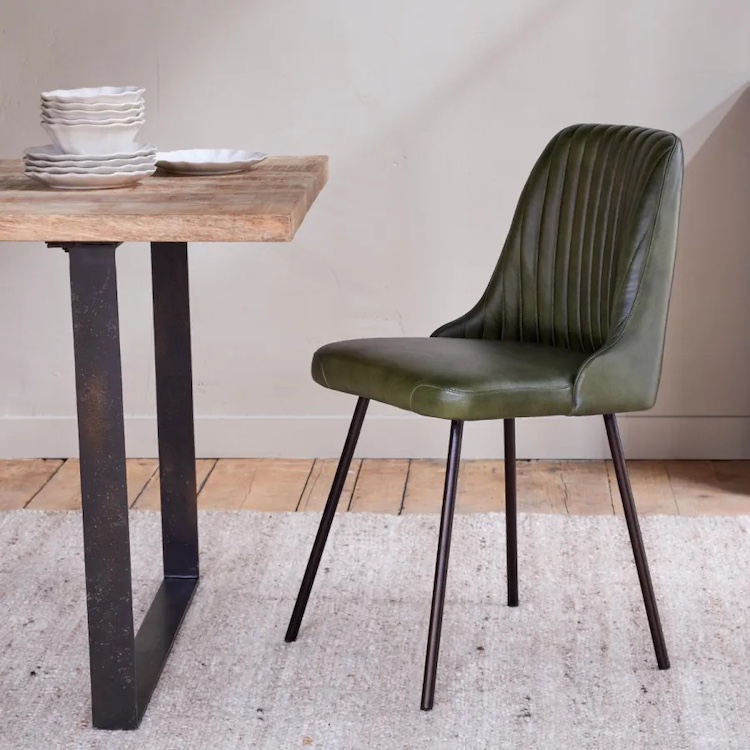
Bring Green into Your Dining Space
Dining areas are often overlooked when it comes to colour, but green can transform them into sociable, stylish spots. Whether it’s a deep leather dining chair or a velvet accent chair, green offers both warmth and sophistication.
If you have a wooden or black dining table, mix in green leather or velvet chairs to soften the look and add visual interest.
The Iswa Green Leather and Rattan Dining Chair brings together dark green leather, natural cane and an industrial iron frame, perfect for relaxed, modern dining.
If you want a bolder statement, the Harsha Rich Green Leather Dining Chair offers a more refined silhouette with its ribbed back and mossy tone, ideal for creating a luxurious dining experience.
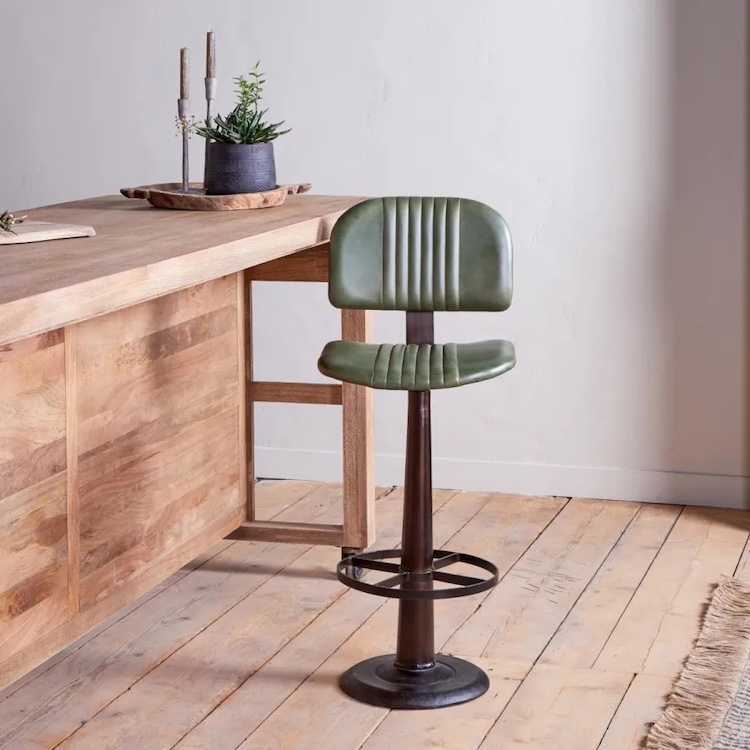
The Narwana Leather & Iron Bar Chair in Rich Green is a striking choice for kitchen islands or high counters, with the leather and stitching adding both texture and depth.
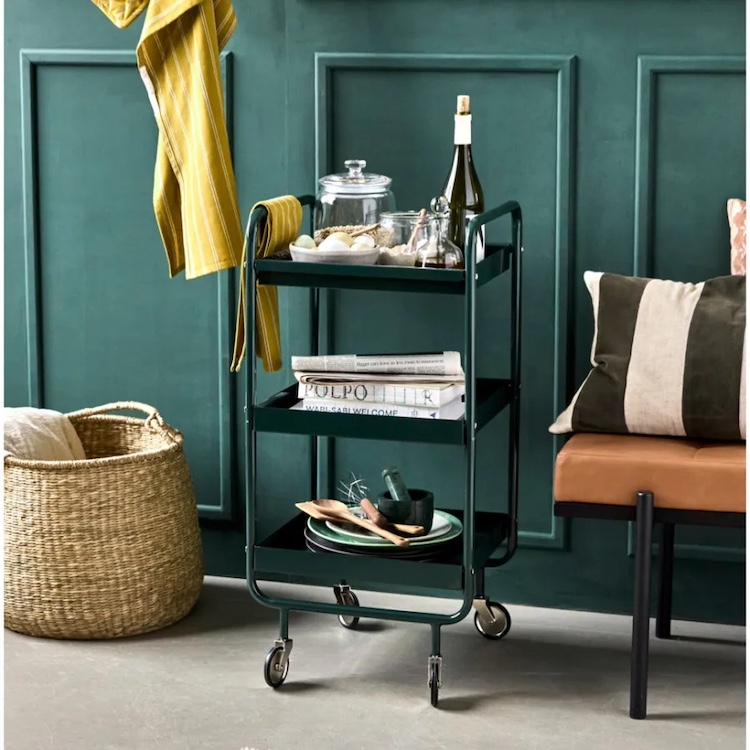
Use Green to Make Functional Spaces Stylish
Storage pieces, trolleys, and desks don’t have to be boring. In fact, they’re often the perfect place to introduce a pop of green in unexpected places.
Green works brilliantly for “utility” furniture. Go bold with block colours or choose pieces with mixed materials like metal and wood to make functional items more fashionable.
The House Doctor Roll Trolley in Dark Green is equal parts stylish and practical, easily brightening up a neutral space. Use it in the kitchen for drinks, in the office for supplies, or in a living room as a mobile bar.
The Dutchbone Finn Ash Desk with Green Velvet Panel elevates your home working environment and adds drama to your home office, with the curved ash wood and velvet detailing offer timeless charm.
.jpg)
Go Big or Keep It Subtle?
For walls, green works beautifully both as a bold feature and as a subtle supporting tone.
- For drama: Paint a single wall in emerald or forest green to create a sophisticated backdrop in a living or dining room. It adds depth and warmth, especially in larger spaces.
- For softness: Use sage or dusty greens across all four walls for a restful, cocooning feel in bedrooms or studies.
- For fun: Try mint green cabinets or tiles in a kitchen or bathroom for a playful, retro-inspired look.
- For balance: If you’re using a lot of green furniture or accessories, balance it out with light neutrals (like off-white, soft grey, or warm beige) to keep the space from feeling heavy.
Use Green Upholstery and Soft Furnishings for Flexibility
If you’re not ready to commit to green walls or large pieces, upholstery and accessories are an easy, low-commitment way to introduce the shade.
Layer various green tones through cushions and throws on a neutral sofa for an instant refresh. Use green textiles to frame windows or ground a space; a rug with hints of green can tie the whole room together.
Upholstered furniture, like ottomans or dining chairs, in green velvet or linen gives a luxe feel without being overpowering.
Accessories are the simplest way to dip your toe into green decor. Cushions, vases, and small tables offer colour and texture without a big commitment.
Choose tactile materials like velvet, leather or marble in green tones to create a sense of richness and comfort.
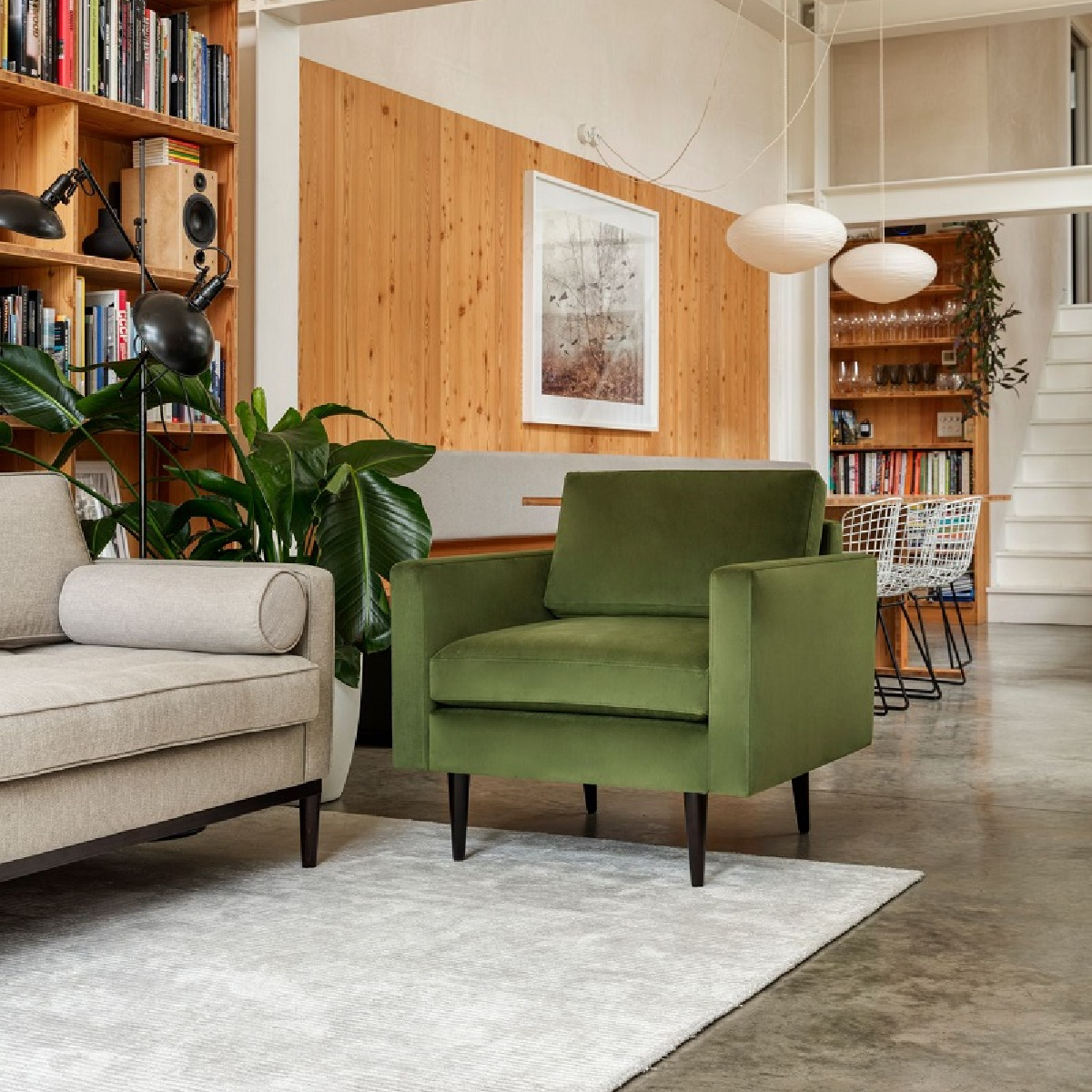
Pair Green with the Right Materials
Green works well incorporated with different texture. Natural materials work especially well because they reflect the connection to nature.
- Wood: Green and wood are a classic combo. Pair sage or olive with warm oak or mango for a timeless, earthy look.
- Brass & gold: Metallic accents elevate deeper greens like emerald and forest, adding warmth and luxury.
- Marble & stone: Pale greens like mint or sage feel ultra-fresh when styled with white marble or stone.
- Leather: Mossy greens and dark olive work beautifully with tan or brown leather for a heritage, library-style feel.
Incorporate Green Through Plants & Botanical Prints
One of the easiest ways to add green is through actual greenery. Real or faux, leafy plants instantly liven up a room and complement green tones in décor. You can use planters in natural materials like terracotta or seagrass to keep the look grounded and organic.
Botanical prints also work well for adding in shades of green. Framed plant illustrations, palm-patterned cushions, or botanical wallpaper bring in green without being literal.
.webp)
Balance Green with Complementary Colours
Pairing green with the right supporting colours brings your design scheme to life. A good tip is to use the 60-30-10 rule. 60% main colour (e.g., soft green walls), 30% secondary (e.g., warm woods), and 10% accent (e.g., brass or terracotta).
Best colours to pair with green:
- Neutrals: White, beige, cream, and grey all balance green beautifully.
- Pinks & blush tones: These add a soft, feminine contrast to cool greens.
- Burnt orange & rust: Create warmth and energy, ideal for boho or eclectic spaces.
- Navy & charcoal: Deep, moody pairings for dramatic and sophisticated schemes.
- Mustard & ochre: Adds a sunny pop against darker greens; great for mid-century or retro styling.
Green isn’t just a trend, it’s a timeless choice that brings balance, vibrancy, and beauty to your home. Whether you go bold with dark walls, add a velvet accent chair, or simply start with a plant-filled corner, there’s a way to make green work for every home and style.

Comments (0)